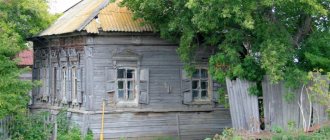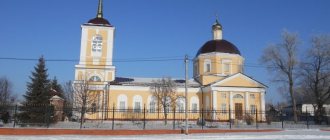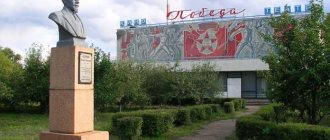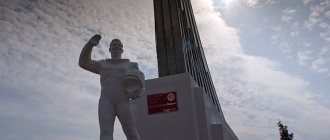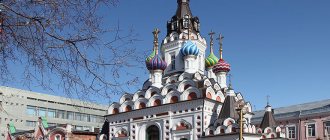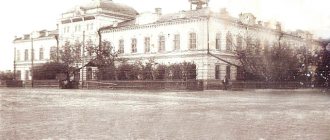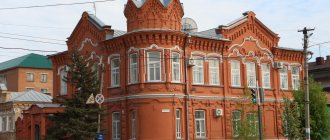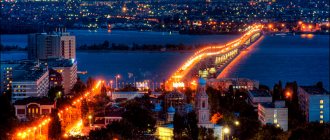This term has other meanings, see Volsk (meanings).
Coat of arms
| City | |
| Volsk | |
- 148 km²
Moscow
Saratov
Volsk
Media files on Wikimedia CommonsVolsk
- a city (since 1780) in Russia, the administrative center of the Volsky district of the Saratov region.
Located on the right bank of the Volga, 147 km northeast of Saratov. Pre-dead end railway station of the Volga Railway on a branch from Volsk 2 station[3].
Population - 60,948[2] people. (2021). Since 2015, Volsk has been awarded the title of City of Labor Glory of the Saratov Region[4][5].
The Annunciation Church was the penultimate one opened in Volsk before the revolution.
Construction began in September 1907. Significant donations were also made by private individuals. Kupets P.E. Begunov, for example, only in 1913 donated 100 rubles for icons for the iconostasis and twenty-five rubles for the refurbishment of ovens that turned out to be unusable. The most generous Volsky benefactor towards the Church, P.F., also donated considerable funds. Kvaskov, who for his attention to the needs of the Annunciation Church under construction in 1912 was awarded a special blessing from the Holy Synod. The consecration of the temple in the name of the Annunciation of the Blessed Virgin Mary took place on February 8, 1914.
Holy Trinity Cathedral
Built in 1809, the cathedral has a long and tragic fate, but a happy ending. After the revolution, fighting against religious prejudices, active Bolsheviks demolished the cathedral building and in its place erected a monument to their revolutionary leader, Lenin.
But at the beginning of this century, justice still triumphed and the temple was restored within three years and now again serves and adorns the city.
Art gallery – MU Volsky Museum of Local Lore
The building, which today houses an art gallery, is an architectural monument of the second half of the 19th century - the former estate of the merchant of the 1st guild, Nikolai Stepanovich Menkov.
Imitation of the Russian Empire style on the facade of the building, the eclecticism of various architectural styles is reflected in the palace interiors of the halls. The exquisite wall paintings, masterly stucco ceilings, and varied mosaics of the parquet floors in each room are admirable.
About 500 museum exhibits are presented in 10 exhibition halls of the art gallery. The main part of the gallery's art collection was formed by 1936. These are works of painting, graphics, and applied art from the noble estates of Counts Orlov - Denisov, Nesselrode, Sheremetev, located on the territory of the Volsky district, as well as from the receipts of the State Tretyakov Gallery, the State Museum of Fine Arts. A.S. Pushkin, Saratov Art Museum named after A.N. Radishchev. Nowadays it is a landmark of the city, surprising visitors with the variety and value of the art collection of Russian, Soviet, Western European painting, graphics, sculpture, and applied art of the 17th – 21st centuries.
Built by love
Soon after the devastating fire of 1792, a regular building plan was developed for the city, which included the creation of a rectangular grid of streets.
The rapid growth of young Volsk is inextricably linked with the name of its second head, Vasily Alekseevich Zlobin, who was not yet 25 years old when he took office in 1784. Born into a more than modest family of a volost clerk, courteous and gentle in his dealings with everyone, Vasily Zlobin rose to the level of one of the richest merchants of his time thanks to chance: with his disposition and helpfulness he was able to make the most positive impression on the prosecutor general who was passing through Malykovka, a favorite Catherine of Prince Vyazemsky. Having first assisted him in choosing lands, he soon began to manage his estates, after which he finally moved to St. Petersburg, taking up trade and farming. Under the wing of an influential patron, Vasily Alekseevich, who had recently been a poor shepherd, quickly became a millionaire, and through his good nature, generosity, simplicity and intelligence, acquired the most useful acquaintances in the capital. He owned wine farms, took contracts for the supply of food to the army, Moscow and St. Petersburg, maintained fisheries in Astrakhan, Saratov and Volsk, supplied salt to twenty provinces of Russia...
Living in St. Petersburg, Zlobin never forgot his small homeland - he constantly took care of the beautification of the city, the construction of new beautiful buildings, bringing the charm of the capital's exquisite architecture to the banks of the Volga. He truly loved Volsk; suffice it to say that of all the many awards and thanks he received, he most valued the title of “eminent citizen”, awarded by grateful Volsk residents for impeccable service by the head of the city.
Having a unique talent for trade speculation, having mortgaged a large number of unfinished buildings in his native Volsk at a deliberately inflated price, Zlobin at the same time was extremely generous and sacrificial when it came to public benefit or serving the state treasury. He not only gave out alms in an unusually abundant manner, forgave considerable sums to debtors, showed unprecedented hospitality, and made outright losses for the benefit of the treasury, but also happily donated to public needs. With his care, new lighting appeared in the capital, hospitals, gardens, greenhouses appeared in Volsk and other cities. Zlobin initiated the installation of a monument to Minin and Pozharsky in Nizhny Novgorod, donating a considerable amount for this. Now this monument adorns the main square of the country, being one of the most recognizable symbols of Moscow. Thanks to the generous hand of Vasily Alekseevich, who turned a blind eye to the often not entirely honest attitude towards himself, many of his partners, contractors and managers were able to break out into the public. Zlobin’s impeccable aesthetic taste, taken as a model by his followers, determined the architectural appearance of Volsk, the absolute dominant feature of which was churches. Vasily Alekseevich himself, donating for the construction and decoration of churches, did not distinguish between the dominant Orthodox Church and the schismatic Old Believers, understanding the unnaturalness of the division.
Through Zlobin’s diligence, by 1809, a cathedral in honor of the Life-Giving Trinity was built on the site of the dismantled dilapidated Kazan Church. In the same year, the construction of a new cathedral in honor of the Beheading of John the Baptist began on the city's Trade Square, more consistent with the new status of a prosperous merchant city. By that time, the construction of the architecturally unique two-story Gostiny Row, the front colonnade of which stretched for an entire block, had already been completed on the square. Not a single county town in the Volga region had a commercial building with a gallery on the second floor.
The Patriotic War of 1812 made its own adjustments to the peace plans of wealthy Volchan residents. Vasily Zlobin's affairs were seriously shaken: a restriction was introduced on the sale of wine, taxes and fees on merchants were increased, and part of the proceeds was hidden by his partners. In addition, an old acquaintance of Vasily Alekseevich, Count Guryev, with whom he had long had strained relations, became the new Minister of Finance.
But the main misfortune befell Vasily Alekseevich the following year: his son Konstantin died suddenly. Zlobin fell into depression, ceased to be interested in business, and died the following year, 1814. It turned out that his debts to the treasury were covered by less than half. The bankrupt Volsky merchants, whose capital was at Zlobin’s disposal, were prohibited from conducting trade operations; many prominent merchants joined the city’s petty-bourgeois class. For many years, the city with its large, abandoned stone long-term construction projects looked empty and unattractive.
Volskaya Children's Art School No. 5 was opened in 1990.
Volsk Children's Art School No. 5 was opened in 1990 as an art school for pupils of Orphanage No. 2 and had only one department of general aesthetic development. In the future, in order not to be confined within the narrow group of the orphanage, other departments for children were created at the school: - in 1992, a music department and a choral singing department were opened; — in 1993, a choreography department was opened and a preparatory department for preschool children began to function; — in 1994, an art department and a choral singing department were opened. The school's activities are aimed at nurturing a harmoniously developed personality in the child. The main task of the school's teaching staff is to develop artistic taste and creative abilities, awakening a sustainable interest in learning, spiritual and aesthetic education of children and adolescents. All this helps the younger generation to love and understand beauty not only in art, but also in life, to bring this understanding into everyday life and behavior, and contributes to the formation of a personality with social and moral stability. The school has an extraordinary atmosphere of warmth, kindness and love.
From free settlement to free city
Great changes in the measured life of the small fishing settlement occurred during the reign of Catherine II. Her manifesto of 1762 “On allowing foreigners to leave and settle in Russia and on the free return to their homeland of Russian people who fled abroad” led to a rapid growth of the Volga region population. Malykovka also grew... Even then, the desire of Malykovka residents for a relatively free and rich arrangement of their homes began to be traced: they tried to build their houses spaciously - with basements, mezzanines, cellars, bathhouses, barns and other outbuildings. And the construction timber for this purpose arrived from the upper reaches of the Volga, including on unique ships - Belyans, nicknamed by our contemporaries “Volga wooden aircraft carriers”. Having reached their destination, such ships were dismantled and sold down to the last plank and rope.
The fugitive Don Cossack Pugachev Emelyan Ivanov's son also took advantage of the permission to return to Russia. Having tried to get permission to settle on Irgiz among the schismatics, he was soon captured in Malykovka for extreme unreliability and dangerous speeches and sent for further investigation to Kazan, from where he fled. A riot broke out across the country, and a young guard officer, Gavrila Romanovich Derzhavin, arrived in Malykovka as a volunteer to capture Pugachev, posing as Peter III. Despite all the efforts of Derzhavin, who was almost captured, both Saratov and Malykovka were taken by robbers. After the suppression of the uprising, Gavrila Romanovich organized demonstration executions in Malykovka of several local residents who particularly distinguished themselves in robbery. Among them was Semyon Sapozhnikov, whose descendants will become famous far beyond the Volga lands. And in “The History of the Pugachev Rebellion,” written by Alexander Sergeevich Pushkin, not only Malykovka itself is mentioned nine times, but also the names of its inhabitants are given.
In order to prevent the repetition of such large-scale unrest in the future, Catherine II ordered in 1780 the formation of several new governorships and county towns, hoping through this to strengthen the sovereign’s power in the rebellious lands. Thus, on the map of the newly formed Saratov governorship, instead of the Malykovskaya settlement, the city of Volgsk appears, for ease of pronunciation it was first called Volzhsky, and then Volsky. The freedom-loving Malykov people put their desire for a free life into the name of the city. The city was given a coat of arms - “a lying bear in a golden field, with which this country abounds in animals.” By the way, ironically, the unusual position of the bear on the coat of arms became an involuntary omen - the last animal in the Saratov province was shot in the Volsky forests at the end of the 19th century by a landowner who was having fun hunting.
Embankment of the city of Volsk on the Volga River.
A small embankment in the city of Volsk, Saratov region, is located on the right bank of the Volga River. It has the shape of an elongated rectangle, into the central part of which there is a descent with steps. It is fenced off from the banks by a low metal fence. Along the well-groomed lawns on the embankment there are asphalt paths with benches and gazebos.
Historical memorials and monuments of Volsk
Tourists should not pass by the monuments installed in the public gardens of Volsk. These compositions will tell you a lot of interesting things about the history of the city.
Memorial complex "Eternal Flame"
- Address: pl. 10th anniversary of October.
The main war memorial is located on the square of the 10th anniversary of the October Revolution. The complex includes the following objects:
- Three plates with the names of Volchan soldiers who fell on the battlefields of the Great Patriotic War. Among them are seven Heroes of the Soviet Union. The Eternal Flame is lit at the foot of the slabs.
- Stone wall with a bas-relief portrait of a soldier and an image of a hand clutching a sword.
The monuments were created according to the design of the artist N.V. Savelyev in 1975. The grand opening took place on May 9, in honor of the 30th anniversary of the Victory.
In the early 2000s, the complex underwent renovation work, during which the inscription on the stone wall dedicating the memorial to the Volchan soldiers was replaced with another - “To the Soldiers of the Motherland 1941-1945.” This replacement caused a wave of indignation among the townspeople. In addition, the soldier’s face was painted over with black paint, which also caused dissatisfaction.
In 2015, the complex was returned to its original appearance. Today it is a military-patriotic property of Volsk and the site of annual rallies.
Monument to Border Guards
- Address: Central Square.
In May 2022, a monument was inaugurated in the center of Volsk, representing a border pillar with the coats of arms of the Russian Federation and the USSR. The memorial is dedicated to all Volchan border guards who gave their lives on the battlefields of the Second World War or in hospitals from wounds received in battle.
The opening ceremony was attended by border guards who came from the cities and villages of the Volsky region, as well as from the Saratov region.
Monument to the sailors of the Volga Flotilla
- Address: st. Stepan Razin.
The monument was erected on the banks of the Volga in 1976. The location for the memorial was not chosen by chance - it was in this place that the sailors who arrived in Volsk to participate in the revolutionary battles landed in 1918. The result of protracted battles was the ousting of counter-revolutionaries from the city. More than 700 Red Army soldiers were rescued from prison by their comrades.
The monument is a stone statue of a fighter who is eager to fight. The granite pedestal is decorated with bas-reliefs of sea anchors.
Obelisk to soldiers who died in the civil war
- Address: pl. 10th anniversary of October.
On the Square of the 10th Anniversary of the October Revolution stands the oldest monument of Volsk. This is a white stone obelisk on the mass grave of two soldiers who died in the battles of the civil war: Sergei Korzhevin and Ivan Semenov.
The obelisk is made in the form of a white stone tombstone with an insert of black tiles. The four corners of the memorial are decorated with cast iron spheres resembling cannonballs. The monument was erected in 1918 shortly after the funeral of the heroes.
Monument to P.D. Grushin
- Address: Maxim Gorky Street.
Pyotr Dmitrievich Grushin is a designer of anti-aircraft missiles who lived in Volsk for a long time. His main merit is that he proved the possibility of detecting and destroying enemy reconnaissance aircraft.
In 1985, a bronze bust of P.D. was unveiled in Volsk. Grushin. The memorial plaque lists all the designer's awards, including two Orders of the Hero of Socialist Labor.
Monument to the first constitution of the RSFSR
- Address: 10th Anniversary of October Square, 4/1.
In 1918, the first constitution of the RSFSR was adopted. A couple of years later, the Volsk administration decided to commemorate this event by erecting a monument.
A competition was announced for the best design of the future monument. The victory was won by the sculptor A. Kobelev. He conceived a complex architectural structure, but due to a limited budget he had to settle for a simple obelisk, shaped like a tribune.
In the 1960s, construction of the Drama Theater began in the park where the monument stood, so it was moved to Dzerzhinsky Street, where the obelisk is located to this day.
Gostiny Dvor building
A large, bright building, decorated on all sides with high columns, like many other city buildings, was built according to the design of the architect Zlobin. According to the plan, shopping arcades were supposed to be located here, but the war with Napoleon ruined the owner and the building fell into disrepair for a long time. Now it contains both modern shopping pavilions and company offices.
Chalk quarry
The secret of the chalk quarry, this is the name of the tourist route leading to an abandoned quarry where chalk was once mined. Now it is a lake formed at the bottom of a quarry with almost overgrown banks and slopes. Going down to the lake along a spiral road, you can study the layers of the earth and even find the remains of disappeared creatures in them. The water in the quarry is clean and local residents often come here to swim.

